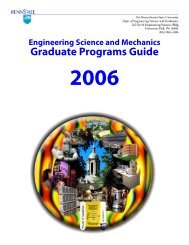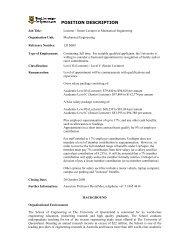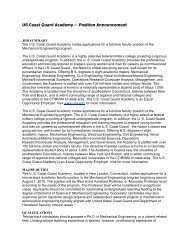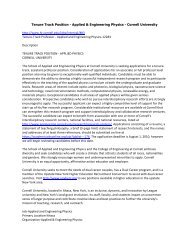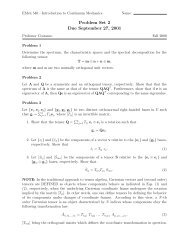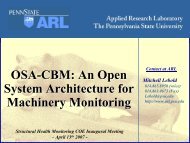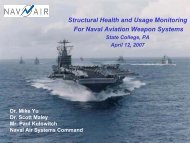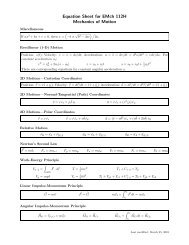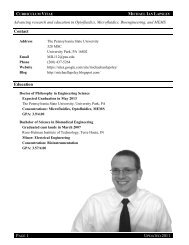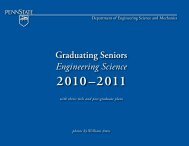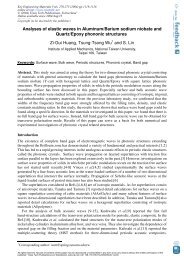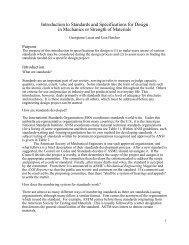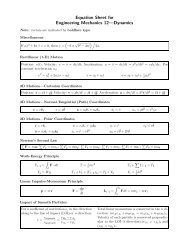Miniaturisation for chemistry, physics, biology, & bioengineering
Miniaturisation for chemistry, physics, biology, & bioengineering
Miniaturisation for chemistry, physics, biology, & bioengineering
You also want an ePaper? Increase the reach of your titles
YUMPU automatically turns print PDFs into web optimized ePapers that Google loves.
Results and discussion<br />
Patterning of micro polystyrene beads<br />
We first examined the ‘‘acoustic tweezers’’ technique in<br />
patterning fluorescent (Dragon Green) polystyrene beads of<br />
mean diameter 1.9 mm. Fig. 2 shows optical images of the 1D and<br />
2D patterning devices. When the SSAW was applied, the beads<br />
aggregated at the pressure nodes, <strong>for</strong>ming 1D and 2D patterns.<br />
The periods of the patterns were measured to be approximately<br />
50 mm (1D pattern in Fig. 2c) and 140 mm (2D pattern in Fig. 2d).<br />
The experimentally measured data matched well with the simulated<br />
results (Fig. S2 b and d, ESI†), which predicted that the<br />
period of the 1D pattern would be half of the SAW working<br />
wavelength<br />
p ffiffi<br />
(50 mm) and that the period of the 2D pattern would<br />
be 2=2<br />
times the SAW working wavelength (141 mm). The size<br />
of the bead aggregations at the pressure nodes (Fig. 2c and 2d)<br />
can be tuned by altering the applied power. Higher power leads<br />
to larger acoustic radiation <strong>for</strong>ces, resulting in close-packed bead<br />
aggregations.<br />
Patterning of cells<br />
We further proved that the ‘‘acoustic tweezers’’ technique can<br />
readily be used to pattern different types of cells—bRBC in<br />
Fig. 3a and E. coli cells in Fig. 3b. These results verify the<br />
versatility of our technique as the two groups of cells differ<br />
significantly in both shape (spherical bRBC vs. rod-shaped<br />
E. coli) and size ( 6 mm vs. 1 mm). Furthermore, the patterning<br />
per<strong>for</strong>mance is independent of the particles’ electrical/magnetic/<br />
optical properties. One concern about this technique is that the<br />
mechanical <strong>for</strong>ces generated by the acoustic waves may potentially<br />
damage cells during the patterning process. For example,<br />
BAW has been widely used in ultrasonic imaging, cell sonoporation,<br />
and ultrasound-enhanced drug delivery. 50–52 In comparison<br />
to these BAW-based techniques, which operate at larger<br />
power intensities (2000–6000 W m 2 ) <strong>for</strong> tens of minutes or even<br />
hours without significantly reducing cell viability, our ‘‘acoustic<br />
tweezers’’ technique used nominal power intensity and took only<br />
seconds to drive cells to pressure nodes. Damages caused by<br />
acoustic <strong>for</strong>ces during this period should be trivial. Once the cells<br />
Fig. 2 Patterning of fluorescent polystyrene microbeads. Optical images of the ‘‘acoustic tweezers’’ devices used in (a) 1D and (b) 2D patterning<br />
experiments, respectively. (c) Distribution of the microbeads be<strong>for</strong>e and after the 1D patterning process. The microchannel (width ¼ 150 mm and depth ¼<br />
80 mm) covered three lines of pressure nodes of the generated SSAW. The wavelength of SAW was 100 mm (see Supplementary Video 1, ESI†). (d),<br />
Distribution of the microbeads be<strong>for</strong>e and after the 2D patterning process. The SAW wavelength was 200 mm.<br />
2892 | Lab Chip, 2009, 9, 2890–2895 This journal is ª The Royal Society of Chemistry 2009



